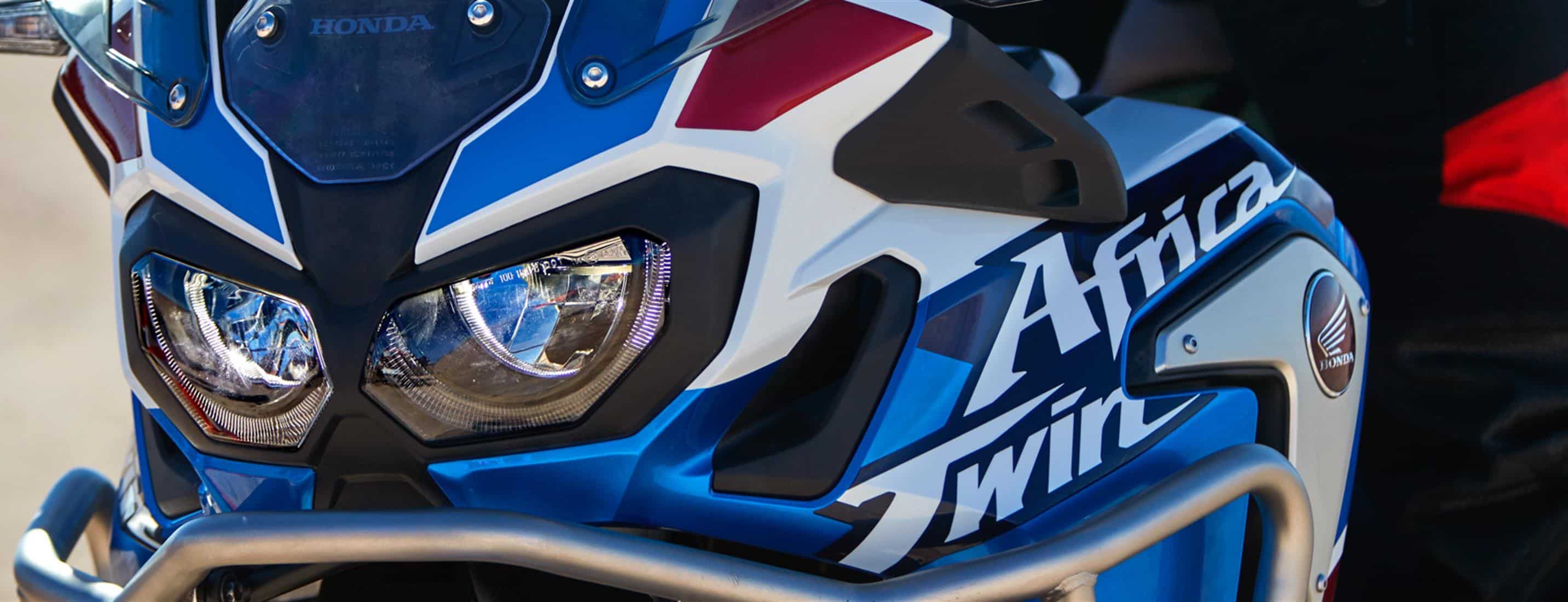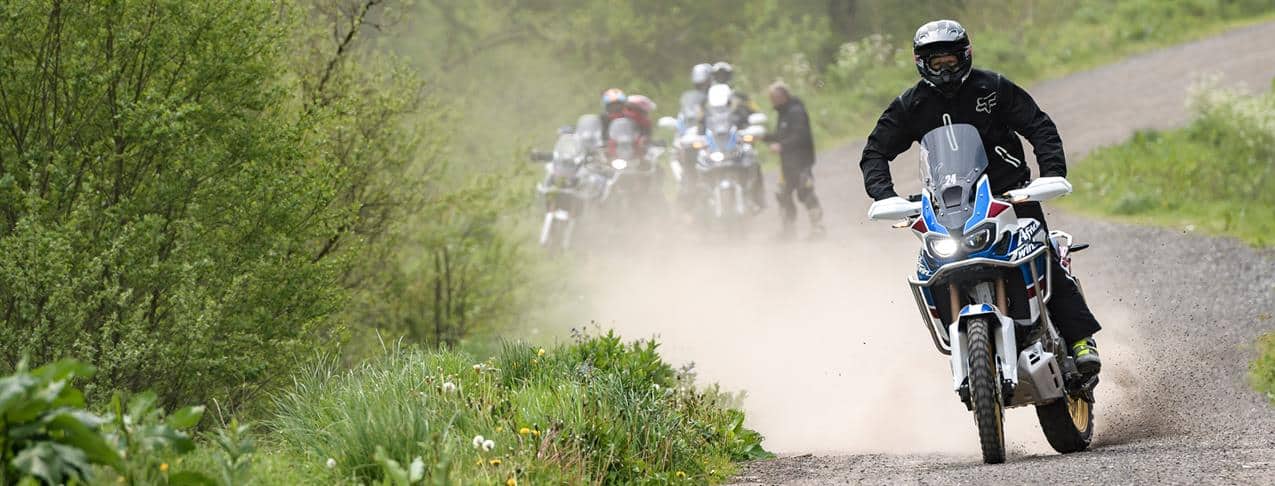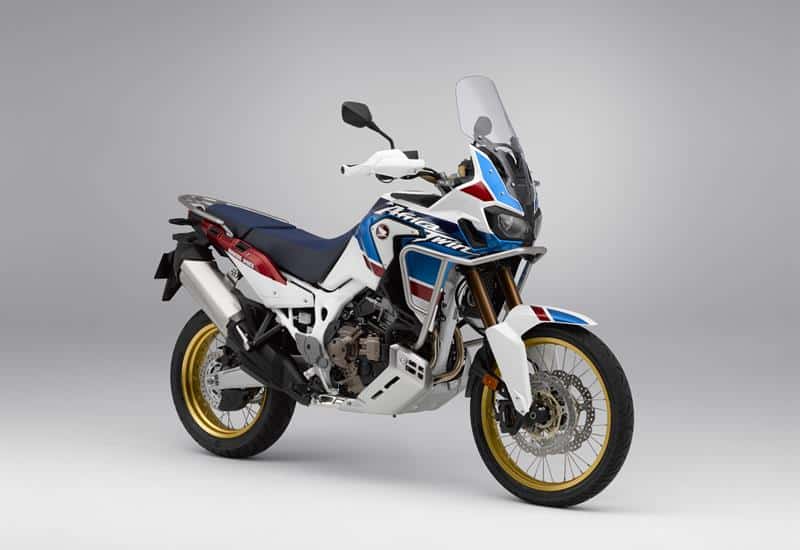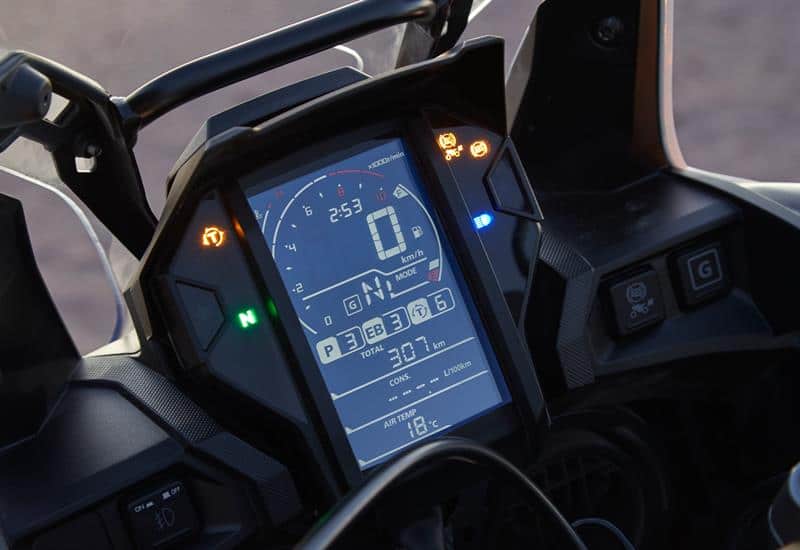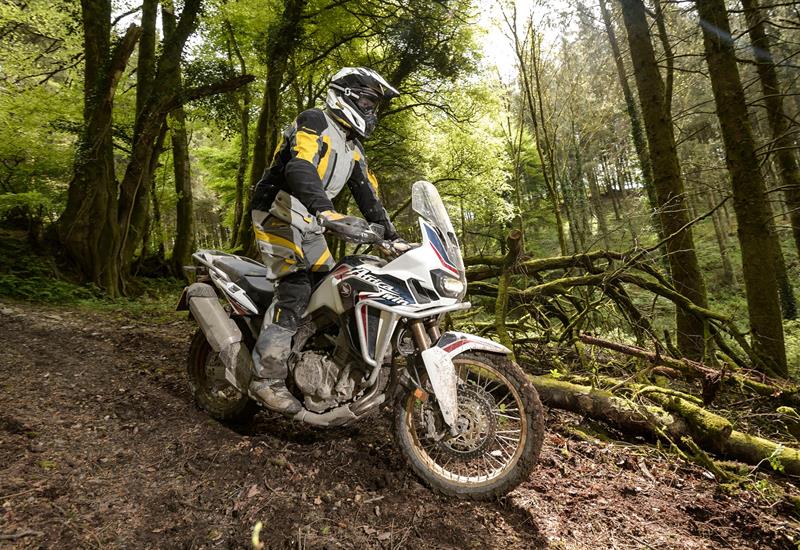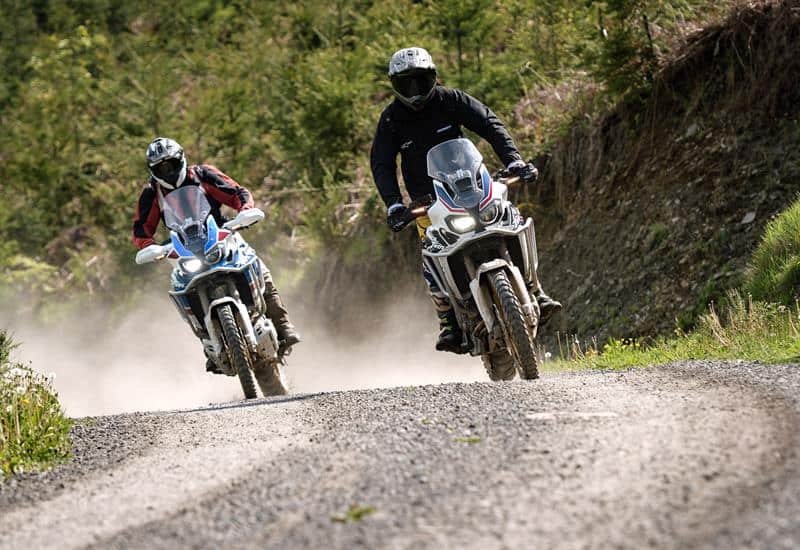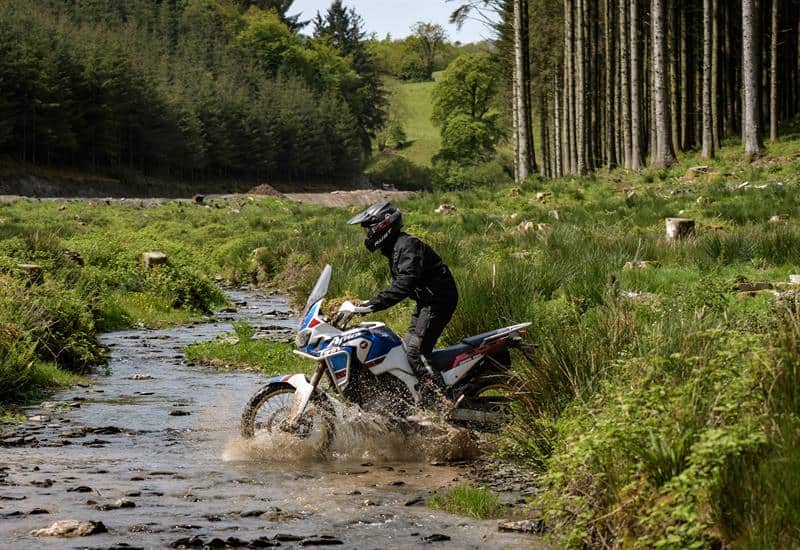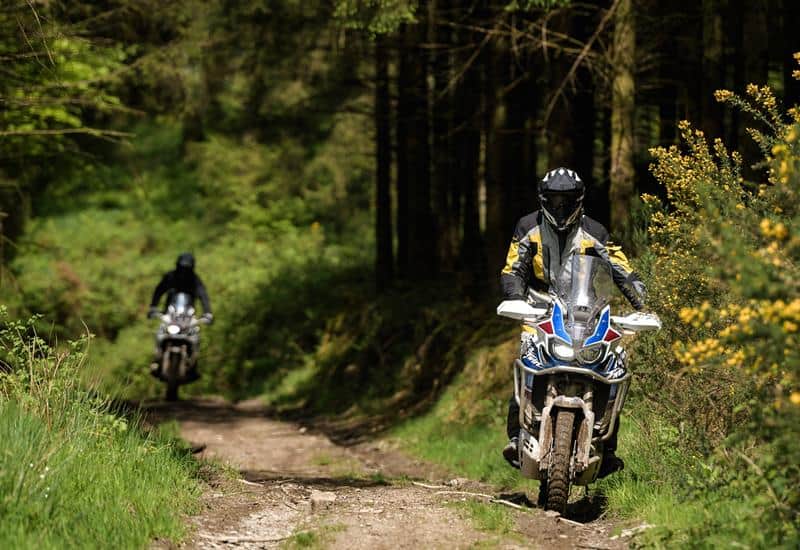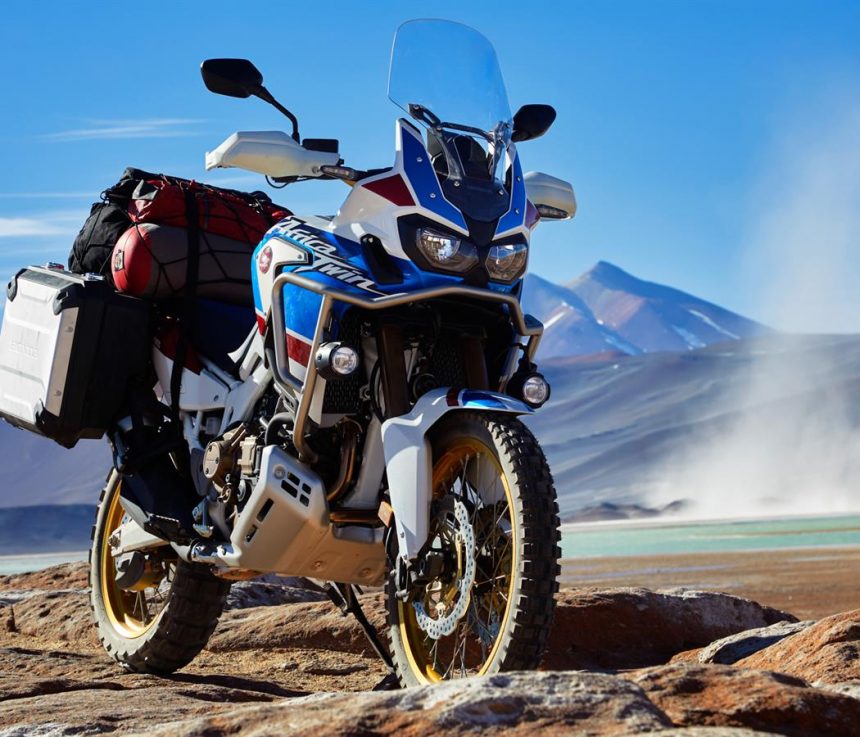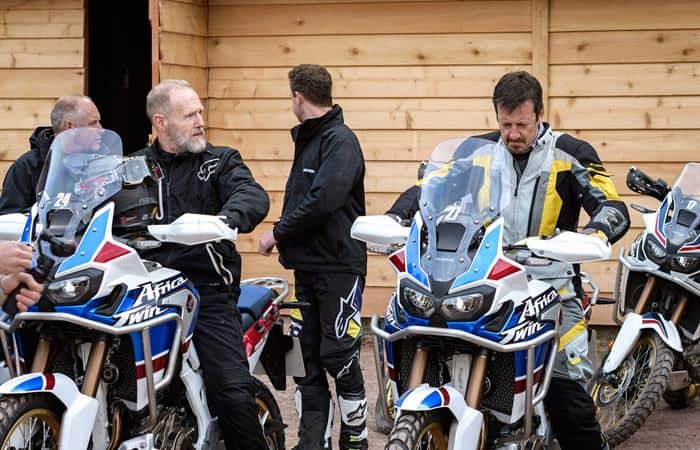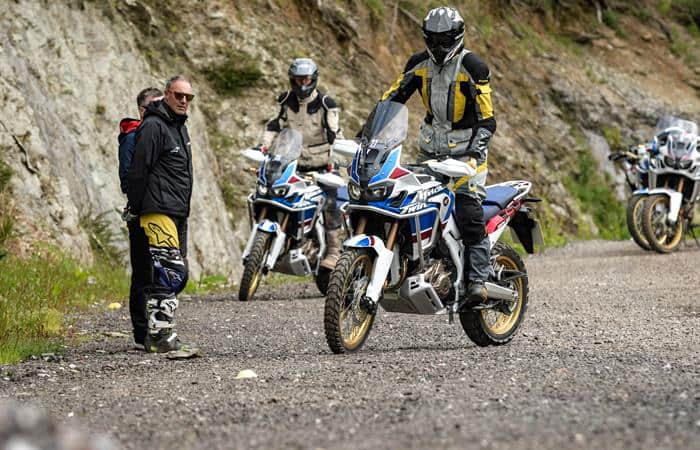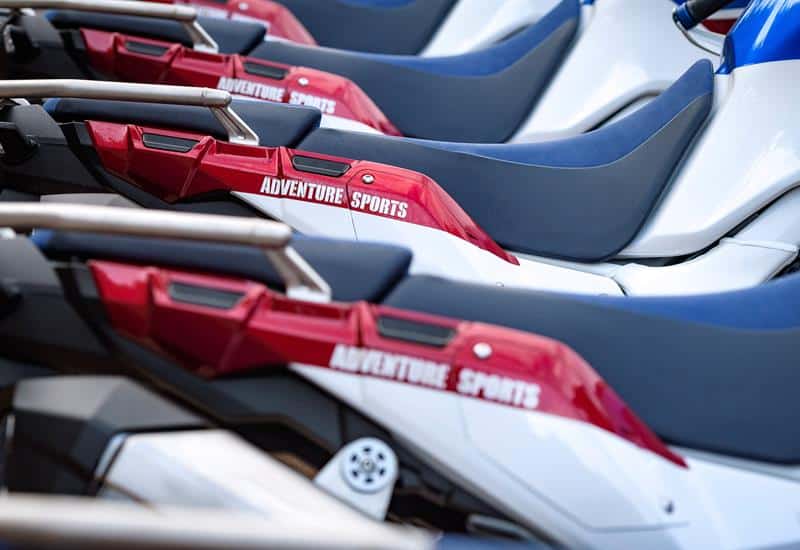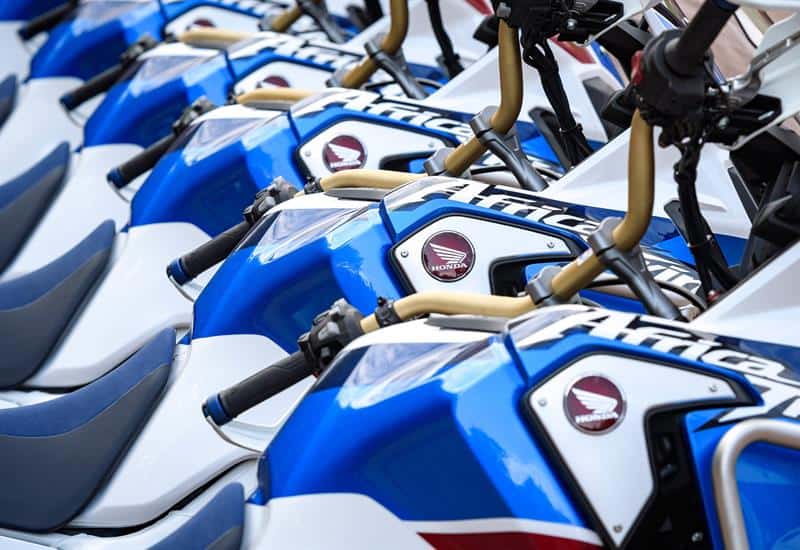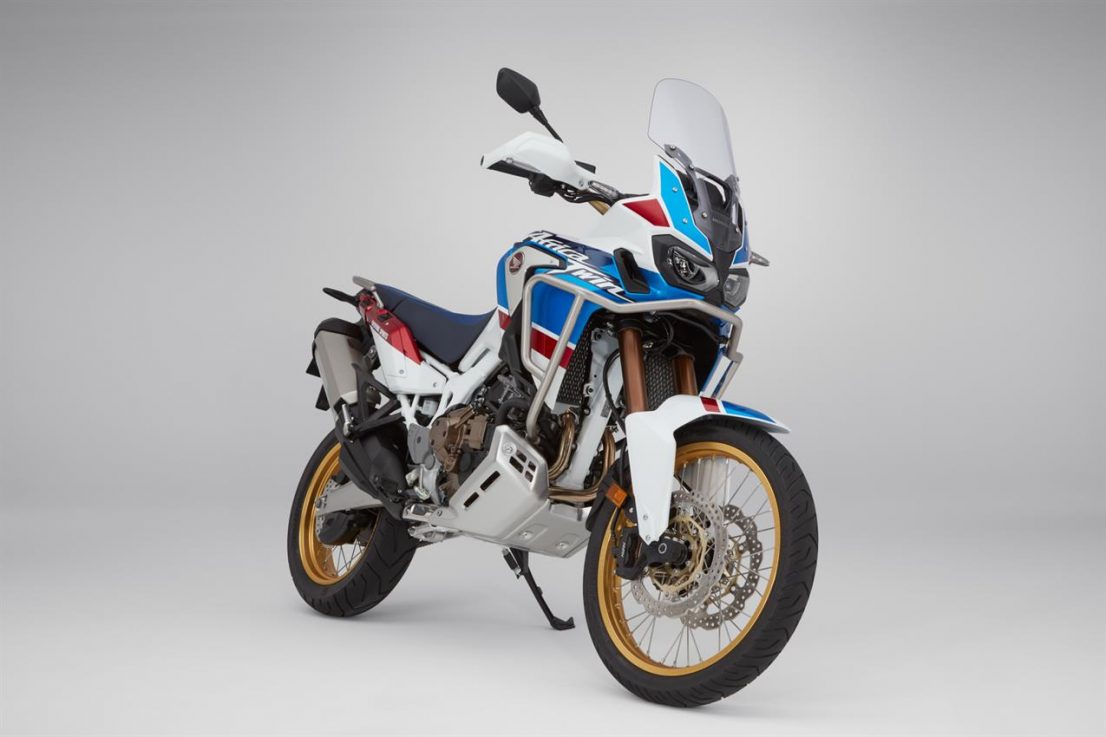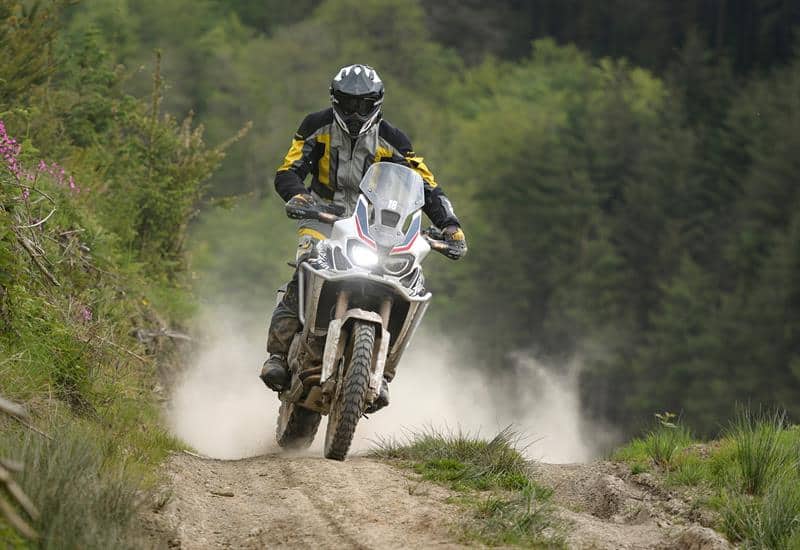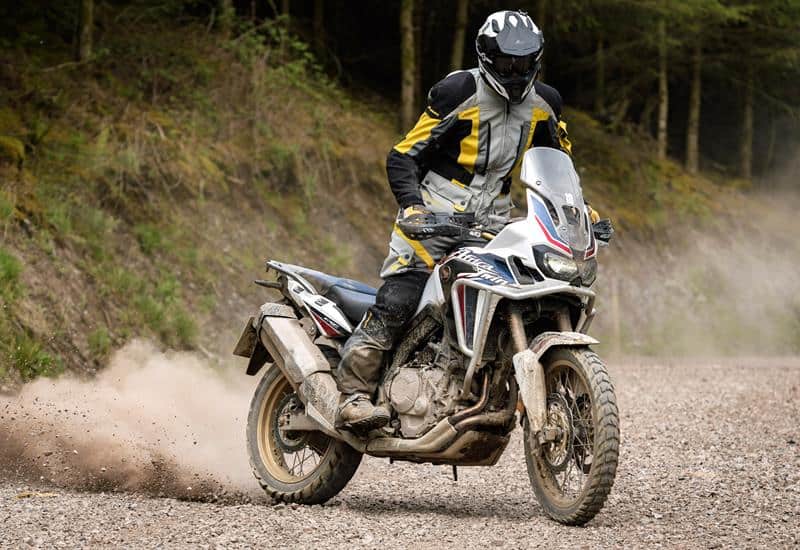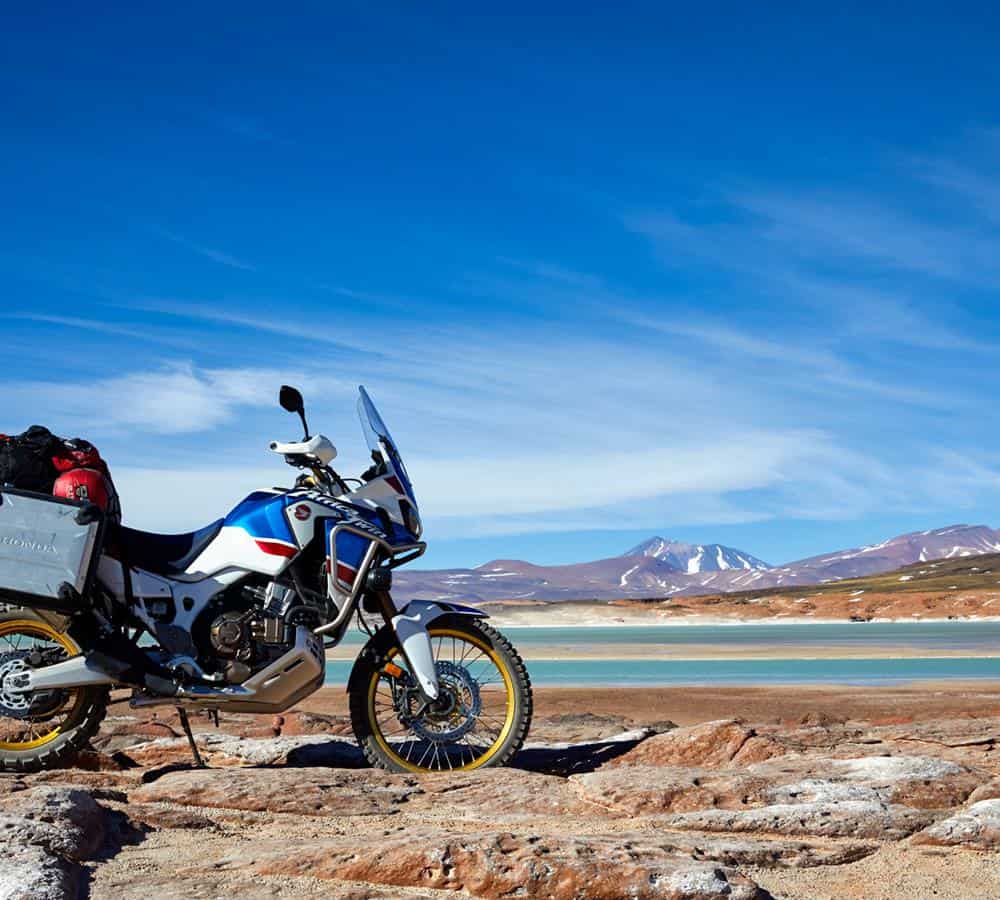I’ve got to hand it to Honda, they have the chassis on the Africa Twin nailed. I’ve just launched the big AT up a gravelly climb and it’s eaten it up. There was a ledge halfway up and it lofted the front over that – I could have gone for big air, but I didn’t take my brave pills at breakfast, so it was just a modest wheelie, while keeping the power on hard in second gear. Then at the top of the climb it skipped an easy diagonal across some mud ruts gone dry. It had then braked and turned left in the one slick movement, using a bank for a berm, before being flicked right for the next climb. It was dynamic, secure and fun. A well-sorted frame working in some harmony with a set of 9” suspension units allied with the off-road optimized 21”/18” wheel combo.
This is the Africa Twin at its best, at home as it were. Its kind of where it’s come from after all, for the original Africa Twin was an evolution of the big trail bike. It’s there in its bloodlines, going back to the XL/XR600s of the early 1980s that scored podiums (if not wins) in the Dakar, through to the first Africa Twin of 1988 – the XRV650 created by the Honda Racing Corporation (HRC) that aped the NXR750 works machines (that Cyril Neveu had raced to Dakar victory for the first time in 1986). The first Africa Twins were not Adventure bikes as we know them now, they were ‘big trailies’ with off-road capability something of a top requisite.
And it’s because of this dynamic that my wing man for the day, Warren M. (the publisher) – an adventure newbie – is really digging this ride. Warren is a dirt biker through and through, motocross first, enduro next, then rally. He doesn’t see the point in 1200cc adventure bikes, doesn’t do ‘adventure’. But the Africa Twin really works for him; it feels like a dirt bike, rides like a dirt bike. His smile – and attitude on the trail – says it all. “Hey bra (South African for ‘bro’ – JB), maybe there is something in this adventure riding after all!”
Africa Twin – reloaded
So here we are looking at the second generation of the new Africa Twin. Having returned to the market after a 13-year absence (in 2016) the Africa Twin has been something of a hit. Slightly bigger than an 800, definitely smaller than a 1200, it found its own groove and has scooped up over 50,000 sales worldwide as a consequence.
In 2016 the AT came in three variants. A basic no frills model, an upgrade with ABS, traction control etc and a DCT (dual clutch transmission) automatic version with all the bells and whistles. For 2018 the model range shrinks to two, but the choice is much more defined. The L model, which we won’t call basic (standard maybe) which gets ABS and all the electronics plus a host of updates, and an L2, more attractively known as the Adventure Sports – a taller option with longer travel suspension and bigger tank among other things. Sorry, is it two? No, as both variants are now available with a choice of either manual or DCT transmissions, that’s four models in all.
The upgrades
New for 2018 is fly-by-wire throttle tech on both variants, known as Throttle-By-Wire by Honda. Of course wires have always operated motorcycle throttles, but the wire in this instance leads to the bike’s computer-like black boxes which then deliver a throttle response according to various factors not least of which is the riding mode that’s been selected (of which there is Tour, Urban, Gravel and User) and the level of traction control (also known as Honda Selectable Torque Control).
That torque / traction control is now deliverable in seven settings (up from three), while the combined engine power and engine braking settings allow three options.
Claimed power is unchanged, but there are detailed changes. The airbox features a 20mm longer funnel that is matched to new exhaust internals for improved mid-range and better sound (more growl). And the balance-shaft has been lightened by 10.6oz for ‘added character and feel’.
The battery has changed to a Li Ion type which saves a fair 2.3kg (5.1lb). And in other detail changes we now have stainless spokes (the originals have been prone to rusting). The footpegs have changed too, wider for 2018. And the revised instrument set is now set at a shallower angle so it can be read easier when standing on the pegs.
Adventure Sports – bigger all round
This new L2 model is to the L as a GSA (GS Adventure) is to a standard GS – it’s the supersized model. Where to start with the differences? Probably with the suspension, which is longer travel by the best part of an inch. The 45mm Showa forks now have a travel of 224mm (8.9” – 8” on the L) while the Showa shock offers 240mm (9.4” – 8.6” on the L). Which means more ground clearance (250mm / 10.6”) and of course a higher seat at 870mm (35.4” – 1.2” higher than the L) although this can be lowered to 850mm.
Then there’s the big tank, a capacious 24.2-litres (6.37 US gallons) as compared to the L’s 18.8-litres (4.97 US gallons). That’s capacity enough for 500km ata time, say Honda. There’s a larger fairing that goes around that tank and a screen that’s 80mm higher. Add to this the protection set, which includes a larger sump guard (aka bash plate) and front ‘light bars’ (aka crash bars). Plus more upgrades, like the heated grips as standard, the 12v accessory socket, brushed aluminium cowling panels, the flatter profile of the seat, the storage pocket in that seat and the tail rack.
For all of this there has to be a penalty – and there is: weight (and cost, of course). The L2 weighs 243kg (533lb) to the L’s 232kg (lb). Then add DCT and the weights go up again by a fair 10kg (23lb) to 253kg.
Happy Anniversary
By the way, the launch of the Adventure Sports also happily coincides with the 30th birthday of the Africa Twin (1988-2018), which has also occasioned Honda to give the new model an extra-special paint job. Aping that very first XRV650 of 1988, the new model gets that distinctive tricolor that features something of a baby blue as well as a spangly red. The effect is simply stunning.
The Ride – Adventure Sports
On road
Make no mistake, this is now one tall bike, albeit there is a grand tradition of tall seats in ‘big trailies’ and adventure bikes – relating as it does, to the virility of the rider (that’s a joke, but like all the best jokes it’s anchored to an underlying truth – only are we talking virility or vanity?). However, you can opt for a lower saddle and then you can lower that further still using the adjusters, so the big bike isn’t off-limits to shorter folk. For me, being 6’0” tall, I ran with the standard set-up, keen to maintain the optimal relationship between that cockpit triangle of pegs to bars to seat. That meant the odd tiptoe moment, but it was fine.
Straight away I liked the new seat, being flattish, not a bucket seat, which makes moving around easier and giving the bike a more dirt bike feel. The handlebars are clamped to a tall set of risers (which proved strong enough in the fair few tip-overs we saw on this test) and are a little more rearward than on the standard L model. For me, I’d like them at least back to where they were, for the handlebars and footrests felt a little too close to each other for a comfortable braced standing position, and when climbing gradients it took more core strength to maintain the standing position. The pegs can’t go back (there’s no adjustment and the exhaust is snugged up behind the right peg in any case), so the answer for taller bods is to go for as forward a position as possible on the bars.
Street riding our way to the off-road part of a our test the general comfort was good, it was comfortable enough, the suspension working well, the tyres (Metzeler Karoo 3s) felt secure, the brakes were good – when crash braking the bike flashes the hazards too – and while the tank is wide at the front, it’s suitably narrow for the rider’s knees when standing or seated. The screen – 80mm taller than on the L – sadly didn’t work for me. There was a fair dollop of turbulence coming off it and – sin of all sins – its not adjustable. So you’re left with the slightly costly option of finding a better one (whether it needs to be taller or shorter, who knows?) or an add-on. A shame because the height worked well for forward vision.
The instrument set I wasn’t enamoured with either (boy, I’m picky). Having recently experienced the wonders of multi-display, multi-colored TFT screens, the black and white digital displays of the Africa Twin were like going back to black and white TV. Perfectly functional, but so outdated. As well – sorry to rub salt in the wound – the plastic screen proved very reflective and when covered in dust made reading the screen a real chore. And sorry again, but the display really needs sorting, it’s cluttered and (on first initiation at least) not very intuitive.
However, when it comes to performance the Africa Twin shines. Bearing in mind this 1000cc motor is under stressed (making very similar power to the competitors’ 800cc offerings) it still feels suitably peppy. Happy to dawdle along (which is super-important in an adventure bike), but engaging when you wick it up. Not super-powerful, but on relatively skinny 21”/18” wheel combination there’s a limit to what you want to mess around with.
Off road
It’s really only off-road you really get into the various settings. And the problem with having so many of them is you need more time than a couple of days to scroll through them all to find what you like.
And one setting I couldn’t quite assimilate to on this test (given the time allowance) was the whole DCT auto-box. Now my first-ever test on an Africa Twin back in 2016 was on a DCT model and I really enjoyed it then. But, here’s a confession, I rode that bike like something of a thug or yob (a ‘thob’ if you like, ©Laura Thompson) never off the gas and firing it through the gears real fast using the finger-and-thumb quick shifter. The trails in Germany were open and fast, it suited the DCT. In Devon we were riding more technical single tracks, with mud and ruts, a terrain where we needed more deft throttle control – and clutch control. And here I was finding I couldn’t transition to a clutchless state with the same ease. I mentally and physically needed the clutch to finesse certain manoeuvres. Now this is a me thing as much as a bike thing – as others made the transition to DCT much more readily than me – but it could be a ‘you’ thing too.
Also, I should add that with multiple settings on engine response as well as torque control I was possibly not on the right settings (for me). I ran with the settings the Dave Thorpe Adventure Centre guys recommended, but there were other options and it is likely I could have found more joy there. And as a further caveat, I can report my old mate Jon Beck (a US journalist) recently tested the Adventure Sport DCT model in the Californian desert and found lots of joy there. So the response to the still newish tech that is DCT clearly depends a fair deal on rider preferences and terrain types. Given that some 50% or so of all Africa Twins sold have been DCT, you can see there’s an even split. So while for now it doesn’t suit me, don’t take that as a measure that it won’t suit you.
There is a bonus with the DCT – I liked the quick shifter arrangement, particularly on the down changes where the throttle is automatically blipped when you press the flapper on the handlebar, helping smooth the transition. There is some degree of finesse in the DCT, I don’t deny that. But who is it that said the greatest computer in the history of the world is the human brain. Maybe not my brain, but you know what I’m saying.
Meanwhile… we’re probably back to the to the top of the story here. Yeah, the overall dynamic of the Africa Twin Adventure Sports in the off-road environment is almost entirely positive. Honda has cleverly stuck to traditional technologies here. That’s a steel semi-double cradle frame, with USD Showa forks and a linkage-actuated Showa monoshock at the rear, riding on 21”/18” wire-spoke wheels. Conventional set-up that leads to conventional feedback – it feels like a dirt bike, just a darn big heavyish one, with mucho power.
The added girth and weight of the Adventure Sports doesn’t impede it from being a decent off-road ride. Everything works as it should. There are a couple of go-to buttons in this instance. When the bike is stopped (they don’t work otherwise) stab at the off-road ABS setting and G-button (for gravel) and these two immediately give you 75% of what you need in the dirt – a lockable rear brake and dirt-appropriate engine responses by way of reducing the clutch slip during gear changes.
However – you knew this was coming – I wasn’t convinced as to the suspension settings for off-road. It was fine for gentle off-roading, but for medium to higher-speed stuff it felt like we needed firmer springs and more damping front and rear – or, as is the case with the high-end kit from Honda’s competition – a capability to electronically beef up the responses. The chassis set-up is capable of great things I’m sure, but I’d want the suspension to be ready to deal with such big hits as might come along and at the moment I’m not convinced that’s the case.
A couple more niggles (I’m sorry, guys). I’d like bigger, better footrests still. Just spec ‘supercross’ or ‘rally’ – the new ones are bigger, better, but they need to be more still. And the rear brake pedal – yeah, that sat too low for standing riding (I like BMW’s solution of a flip-down added pedal) and the rear brake seemed to lack feel – a change of pads might help there.
Overall though – please take my criticisms as nit picking – the Adventure Sports still impresses. It looks amazing and it goes so well.
The ride – the Africa Twin L (standard)
Off road
Now the standard bike was not the headline news here, although like the Adventure Sports edition it’s gained a whole bunch of revisions. Only here comes another confession – I loved this bike! The Adventure Sports is a thing of brutish proportions and some beauty but the humble L really cuts it in the off-road, and for me that’s a big win.
Lots of things must contribute to this. The reduced stature helps, the L is immediately less intimidating. The lower seat height will help many. And the weight saving really makes a difference, if you compare a manual L to a DCT L2 we’re talking a weight difference in the order of 21kg – and that really is telling when you’re flicking a bike around in the dirt, especially tight tricky Devonshire forest dirt. You wouldn’t think there’d be that much of a difference, but if the Adventure Sports felt like say a KTM 500EXC then by comparison the L felt like a 250 or 350EXC, you just felt you could boss it around that much more. As we say all too often, less is more.
And while I’m here, one more gripe. For me on the evidence of these two days riding, I’d like to see Honda work a little more magic into their rider aids – alternatively I need a good week to work through what we have, see if I can find a JB setup. Jump on a BMW or Triumph and you can select Enduro Pro and you’ve pretty much got the job nailed, the bike becomes a weapon. On the Hondas, hmmm, I wasn’t finding joy in any of the seven settings for the traction (torque) control and for off-road in the end I went for zero TC as even on 1 I wasn’t getting the responses I wanted. I wasn’t entirely happy with the engine responses either – not sure if I need more or less there. And I’d love the suspension to have a ‘big action’ mode.
So, where are we at?
Honda have improved the Africa Twin, of that there is no doubt. And I love the addition of the Adventure Sports model, it is probably the most handsome adventure bike on the market today, it is one serious glamour puss. I like, too, that Honda have taken their own interpretation on adventure. They’ve stuck with the near-100 horsepower and 1000cc parameters. And we don’t need more power if we’re honest. This bike answers to those who like dirt capability above the big tour option.
But do Honda have a market leader in the Africa Twin? On sales that’s looking very close to being the case, only BMW’s imperious GS stands above it. But I can’t help the feeling there’s a ways to go yet, Honda still needs to come up to speed on a few things before we can call them outright champs. Particularly there’s still a little work to do on the electronics – the base package (the motorcycle) is gold, it’s the add-ons that for me are letting the side down. Having recently stepped off Triumph’s Tiger 800XCa I’ve got experience of a well-optimised set of rider aids. In many ways I prefer the Africa Twin’s gutsy twin-cylinder motor, but it needs (deserves!) the smoothing and assured direction of the Tiger’s tech pack. This, I don’t doubt, will come.
In the meantime would I advise buying? Yes I would, absolutely, both variants are still great bikes that really engage the rider and while being strong off-road propositions are super comfortable on-road too – real all-rounders. I’d be strung between two posts on which model to buy, though. I’m a manual gearbox man for sure, but standard or Adventure Sports? I love the dynamic of the former and the dash and sheer presence of the latter. Aww, decisions, decisions…
WHAT’S NEW FOR 2018
Fly-by-wire throttle
Airbox funnel 20mm longer
Lighter balancer shaft
Li Ion battery, saving 2.3kg
7 torque (traction) control settings (previously 3)
Instrument set revised and set at shallower angle
Stainless steel spokes
Wider footpegs
THE ADVENTURE SPORTS UPGRADES
Larger fairing, screen is 800mm higher
Bigger tank, 24.2 litres
Larger sump guard
‘Light bars’ (aka crash bars)
Higher seat, now 870mm
Longer forks, 224mm travel
Longer shock, 240mm travel
More ground clearance, 250mm
Heavier – 243kg (with DCT – 253kg)

